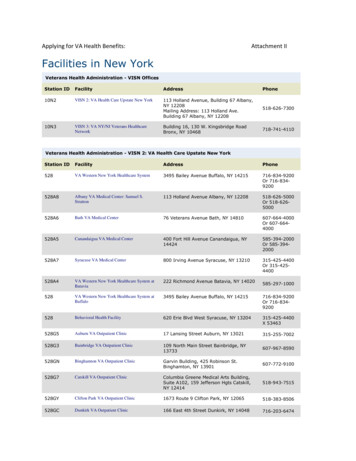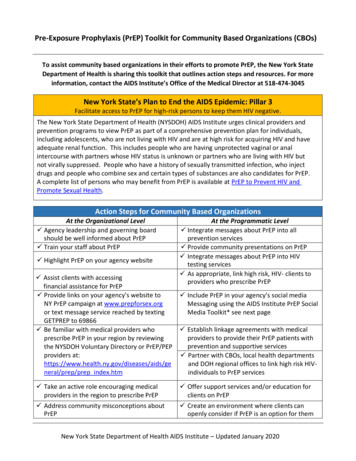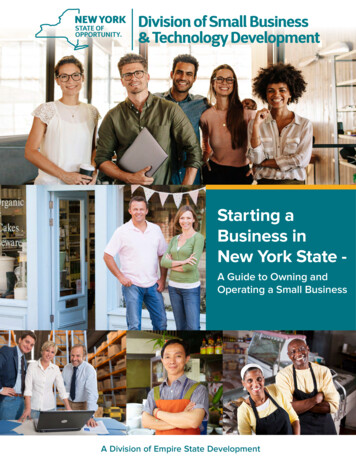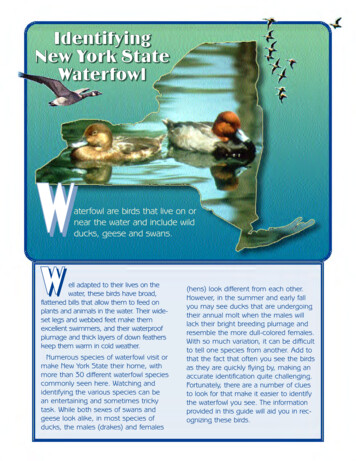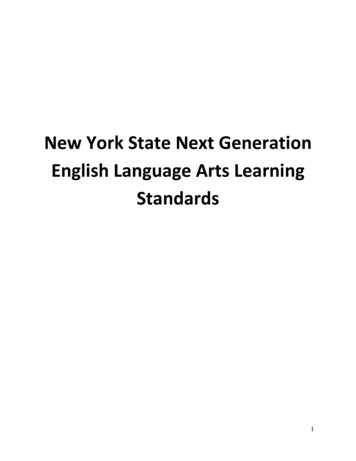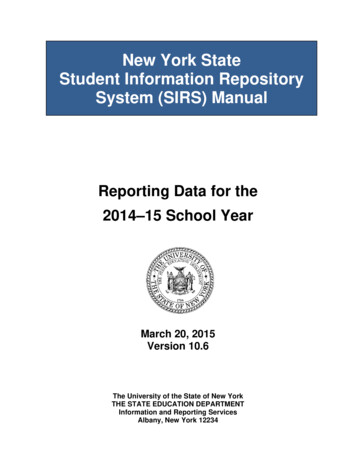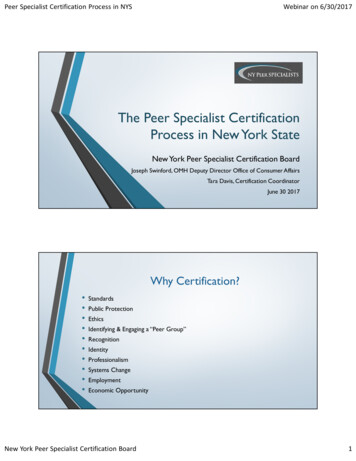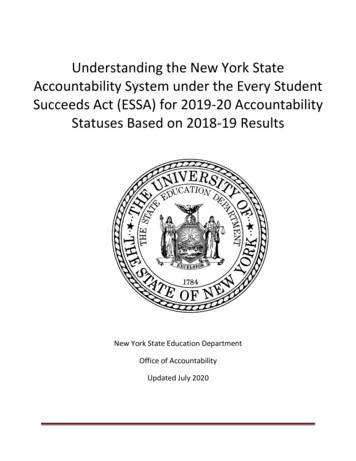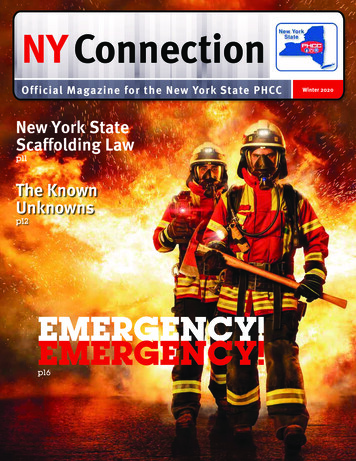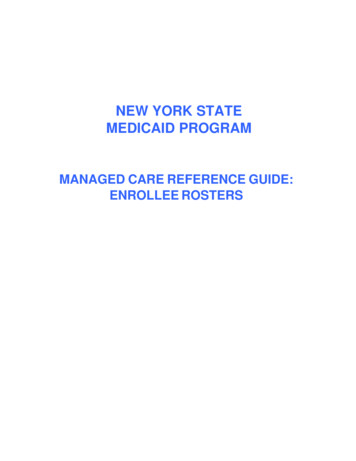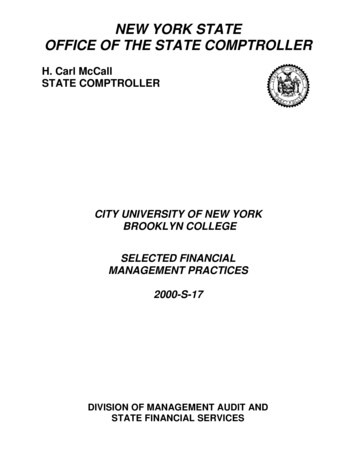
Transcription
NEW YORK STATEOFFICE OF THE STATE COMPTROLLERH. Carl McCallSTATE COMPTROLLERCITY UNIVERSITY OF NEW YORKBROOKLYN COLLEGESELECTED FINANCIALMANAGEMENT PRACTICES2000-S-17DIVISION OF MANAGEMENT AUDIT ANDSTATE FINANCIAL SERVICES
H. Carl McCallSTATE COMPTROLLERReport 2000-S-17Dr. Matthew GoldsteinChancellorCity University of New Yorkth555 East 80 StreetNew York, NY 10021Dr. Christoph M. KimmichPresidentBrooklyn College2900 Bedford Avenue at Avenue HBrooklyn, New York 11210-2889Dear Chancellor Goldstein and President Kimmich:The following is our audit report on selected financial management practices at the CityUniversity of New York Brooklyn College.This audit was performed pursuant to the State Comptroller's authority as set forth in Article V,Section 1 of the State Constitution and Article II, Section 8 of the State Finance Law. Majorcontributors to this report are listed in Appendix A.April 12, 2001Division of Management Audit and State Financial ServicesA.E. SMITH STATE OFFICE BUILDING ALBANY, NEW YORK 12236123 WILLIAM STREET NEW YORK, NEW YORK 10038
Executive SummaryCity University of New YorkBrooklyn CollegeSelected Financial Management PracticesScope of AuditBrooklyn College (College), which was established in 1930, is one of 11senior colleges in the City University of New York (CUNY) system. Locatedin the Flatbush section of Brooklyn, the College offers more than 125undergraduate and graduate majors and programs. During Fall 1999, theCollege enrolled approximately 15,000 students and employed 2,254 staff,including 1,264 instructional staff. For fiscal year 1999-2000, the College’stotal operating budget was 73.2 million. The College processes its payrollon the State’s Payroll System Replacement Project (PaySR) and accounts forits student and financial information on CUNY’s on-line Student InformationManagement System (SIMS).Our audit addressed the following question about selected financialmanagement practices at the College for the period July 1, 1999 throughAugust 8, 2000:!Audit Observationsand ConclusionsDoes the College maintain adequate internal control over its payrolland revenue functions?We conclude that there are certain College controls over payroll and revenuethat need to be strengthened. The areas of payroll and revenue where controlsneeded improvement include distributing paychecks, recording of employeeSocial Security numbers on PaySR, delivering employee W-2 forms, issuingstudent tuition refunds, handling outstanding student refund checks, andregistering students with unpaid balances.The Office of the State Comptroller’s (OSC) Payroll Manual requires thatundistributed payroll checks be returned to the New York State Departmentof Taxation and Finance within 30 days of the date of the checks. However,we found that the College had 37 undistributed payroll checks over 30 daysold that totaled 10,560. We also found that College payroll records, whichshould list accurate and valid employee Social Security numbers, containedquestionable numbers for some employees. Further, the College did notalways comply with PaySR guidelines for W-2 forms, which require thatthese documents be distributed or returned to OSC in a timely manner. Wefound that 41 W-2 Forms of current or former employees were neitherdistributed nor returned to OSC in a timely manner. These employees may
have failed to file returns to pay taxes or get refunds of taxes withheld, or mayhave underreported their income. We recommend that the College improvecontrols over payroll functions by establishing policies for undistributedpayroll checks, by verifying employee Social Security numbers, by obtainingadditional PaySR training for staff and by returning undeliverable W-2 formsto OSC in a timely manner. (See pp. 3-6)The College should remit student tuition refunds promptly so students havethe use of funds owed to them. However, we found that, for the three monthsended March 31, 2000, the College issued 94 refund checks, totaling 48,000for the Spring 1996 through the Fall 1998 semesters. Refund checks shouldbe invalidated if they remain outstanding for a long time to simplify checkingaccount reconciliation and to reduce the risk that these funds could be subjectto misuse. However, when we reviewed a judgmental sample of 21 of the 132outstanding checks listed in the College’s March 31, 2000 bank statement, wefound that some of these checks were almost two years old. We recommendthat the College remit refunds in a timely manner and invalidate refundchecks after a reasonable time period. (See pp. 8-9)CUNY prohibits students who are delinquent in paying tuition for a currentsemester from registering in a subsequent semester. Despite that policy, wefound that 31 students who owed tuition payments of 1,000 or more from theFall 1999 semester were allowed to register for the Spring 2000 semester. Werecommend that the College comply with CUNY registration policies. (Seepp. 9-11)Comments ofCUNY OfficialsCollege officials generally agree with our recommendations. They add thatsteps were taken or planned to correct the weaknesses during the audit.
ContentsIntroductionPayrollRevenueAppendix AAppendix BBackground . . . . . . . . . . . . . . . . . . . . . . . . . . . . . . . . . .Audit Scope, Objective and Methodology . . . . . . . . . . . . .Internal Control and Compliance Summary . . . . . . . . . . . .Response of Brooklyn College and CUNY Central Officials.to Audit.1122Undistributed Payroll Checks . . . . . . . . . . . . . . . . .Verification of Employees’ Social Security NumbersDistribution of Employee W-2 Forms . . . . . . . . . . .Recommendations . . . . . . . . . . . . . . . . . . . . . . . . .3457Tuition Refunds . . . . . . . . . . . . . . . . . . . .Outstanding Refund Checks . . . . . . . . . . . .Students with Outstanding Tuition BalancesRecommendations . . . . . . . . . . . . . . . . . . .88911.Major Contributors to This ReportComments of CUNY Central and College Officials.
IntroductionBackgroundBrooklyn College (College), located in the Flatbush section of Brooklyn, isone of 11 senior colleges in the City University of New York (CUNY)system. As of Fall 1999, the College had an enrollment of 15,000 students,including 10,000 undergraduate and 5,000 graduate students. As of April2000, the College had approximately 1,033 full-time employees, 63 graduateassistants and 1,158 part-time employees. For fiscal year 1999-2000,personal service costs represented 65.8 million of the College’s operatingbudget of 73.2 million. College revenues for the fiscal year ended June 30,1999 were approximately 131.7 million. Major sources of revenueincluded tuition and fees of 44.7 million, State aid of 68.4 million andFederal aid of 13 million. For the 1999-2000 academic year, tuition forfull-time students was 3,200 for State residents and 6,800 for out-of-Stateresidents.The College Bursar’s Office collects tuition and fees from students andissues certain refund and salary checks. The College Office of PayrollOperations processes all personnel transactions for employees paid from taxlevy funds. This processing is performed on the New York State PayrollSystem Replacement Project (PaySR) which is operated by the Office of theNew York State Comptroller (OSC). The College maintains and tracksstudent account data using CUNY’s on-line Student Information System(SIMS).Audit Scope,Objective andMethodologyWe audited selected financial management practices at the College for theperiod July 1, 1999 through August 8, 2000. The objective of financialrelated audit was to evaluate the adequacy of the College’s internal controlsover the payroll and revenue functions. To accomplish this objective, wereviewed the College’s policies and procedures, applicable rules andregulations and other appropriate documentation.We interviewedmanagement and staff from the College and CUNY Central. We also spoketo representatives of commercial banks chartered in New York State, andwe interviewed Office of the State Comptroller staff responsible for PaySR.In addition, we observed a payroll distribution at the College, tested selectedcontrols and transactions and used VERIS diagnostic software to analyzeCollege employee Social Security numbers found on PaySR.We conducted our audit in accordance with generally accepted governmentauditing standards. Such standards require that we plan and perform ouraudit to adequately assess those operations of the College which areincluded in our audit scope. These standards also require that we
understand the College’s internal control structure and its compliance withthose laws, rules and regulations that are relevant to the College’soperations which are included in our audit scope. An audit includesexamining, on a test basis, evidence supporting transactions recorded in theaccounting and operating records and applying such other auditingprocedures as we consider necessary in the circumstances. An audit alsoincludes assessing the estimates, judgments and decisions made bymanagement. We believe that our audit provides a reasonable basis for ourfindings, conclusions and recommendations.We use a risk-based approach when selecting activities to be audited. Thisapproach focuses our audit efforts on those operations that we haveidentified through a preliminary survey as having the greatest probability forneeding improvement. Consequently, by design, finite audit resources areused to identify where and how improvements can be made. Thus, wedevoted little audit effort to reviewing operations that may be relativelyefficient or effective. As a result, our audit reports are prepared on an“exception basis.” This report, therefore, highlights those areas needingimprovement and does not address activities that may be functioningproperly.Internal Controland ComplianceSummaryResponse ofBrooklyn CollegeOfficials to AuditOur consideration of the College’s internal controls identified certainweaknesses with respect to the payroll and revenue functions. Theseweaknesses are explained in the sections of this report entitled “Payroll” and“Revenue.”A draft copy of this report was provided to College and CUNY Centralofficials for their review and comment. Their comments were consideredin preparation of this report and are included as Appendix B.Within 90 days after the final release of this report, as required by Section170 of the Executive Law, the Chancellor of the City University of NewYork shall report to the Governor, the State Comptroller and the leaders ofthe Legislature and fiscal committees, advising what steps were taken toimplement the recommendations contained herein, and whererecommendations were not implemented, the reasons therefor.2
PayrollPayroll is the most significant component of the College’s annual costs.Effective internal controls over payroll are necessary to ensure there is nowaste or abuse involved in this cost. Our audit shows that the Collegeneeds to take certain steps to improve control over paycheck distribution,the recording of Social Security numbers in PaySR and the delivery ofemployee W-2 forms.UndistributedPayroll ChecksChapter E, Section 1 of the OSC Payroll Manual (Manual) requires thatundistributed payroll checks that have not been delivered to employees mustbe returned to the New York State Department of Taxation and Finance(Department) within the 30-day period following the dates of the checks.However, during our observation of the distribution of College paychecksfor the payroll period ended May 17, 2000, we found that the College hadon hand 37 undistributed payroll checks, with a total value of 10,560,owed to 11 employees. These checks had been issued during payrollperiods that ended between February 10, 2000 and April 6, 2000 and werebetween 41 and 97 days old.At the time of our field work, the College did not have a written policy forthe disposition of undistributed payroll checks. Officials from the CollegeBursar’s Office told us that their check distribution unit routinely heldunclaimed payroll checks for three pay periods before sending them to theCollege Office of Payroll Operations. The Office of Payroll Operations isresponsible for the disposition of these checks, including mailing them tothe last known addresses of payees, and finally sending undelivered andundistributed checks to the Department. We discussed the State’srequirements with College officials, and pointed out that the longer thechecks are held, the greater the risk that they could be misplaced, mishandled or misappropriated. In responding to our findings, College officialsstated that they had initiated a policy, effective October 2, 2000, to ensurecompliance with the Manual. To better control these checks and to improvethe timeliness of their disposition, we recommend that the Bursar’s Officesend the checks to a unit independent of the payroll process. Theindependent unit should then maintain custody of the checks until they areforwarded to the Department.(In responding to our audit report, College officials stated that the Office ofthe Bursar, which is independent of the payroll process, will mail allunclaimed checks to the payees within 20 days of the pay date. All suchchecks will include the return address of the College’s internal controlofficer, whose office will review any returned items. They also said all3
College employees have been notified via memorandum of this policy andapplicable procedures have been modified.)Verification ofEmployee’s SocialSecurity NumbersFederal regulations require the payroll record to include the correct SocialSecurity number (SSN) of each individual employee. Chapter A, Section4 of the Manual states that this number, which is required for identifying anemployee record, is to be used for reporting wages covered under the SocialSecurity law, for recording the amount of payroll taxes to be withheld fromthe employee’s paycheck and for differentiating between employees whohave similar names. The Manual further states that the SSN must bereported for every employee added to the payroll, whether or not theemployee is subject to Social Security deductions, and that the employeemust produce his or her Social Security identification card at the start ofemployment. In addition, the Manual requires agencies to ensure that SSNdata is entered correctly on payroll forms and other internal records.We obtained the records of all College employees listed on the payroll fromJuly 1, 1999 to June 30, 2000. Using VERIS diagnostic software, whichdetects questionable SSNs, we identified 79 employees whose SSNs wereproblematic. When we checked College’s personnel files for these 79employees, we found that the SSNs for eight had been incorrectly recordedon PaySR. In addition, the SSNs for five were invalid numbers. The SSNsfor the remaining 66 employees appeared to be valid ones that had beencorrectly established by the College. In addition, during our examination, wefound that PaySR listed more than one SSN for another 15 employees whowere not part of the sample of 79.We determined that the College Office of Payroll Operations does not havea process for ensuring that SSNs are entered correctly on PaySR or thatinvalid numbers are detected. In addition, College officials told us that theydo not require new employees to show their Social Security cards when theyare first hired, and that they temporarily use resident alien registrationnumbers and other “dummy” numbers in lieu of SSNs for some newemployees. They also told us that the SSNs of some employees wereinadvertently transposed at the time the College’s payroll system wasconverted to PaySR in 1998. Moreover, they claimed that the process ofdeleting and replacing incorrect numbers is difficult and time-consuming,and that College staff had received minimal basic PaySR training when thesystem was implemented.If an employee does not provide the employer with a valid SSN, or ifCollege staff enter the number incorrectly on PaySR, the appropriateearnings and tax withholding data will not be reported accurately to local,4
State and Federal authorities. In addition, the employee’s Social Securityand Medicare contributions will not be credited to the proper accounts.In responding to our preliminary audit findings, College officials agreed tocorrect the SSN exceptions that we identified, and to obtain additionalPaySR training for their payroll staff. They also indicated that they willmodify their procedures to require that a new employee’s SSN be submittedbefore that employee is added to the payroll system. Officials further statedthat appropriate edit checks will be included in their new accounting systemcurrently under implementation. The edit checks could flag SSNs that areinconsistent with those issued by the Social Security Administration (SSA).Officials also expressed interest in obtaining VERIS software so they couldverify Social Security data in PaySR. Subsequent to the completion of ouraudit, OSC’s Payroll Unit executed an arrangement with SSA to matchPaySR SSNs with the official numbers residing with SSA. Plans arecurrently underway for implementing this matching capability.(In responding to our audit report, College officials stated that they havecorrected the SSN exceptions that we identified and that they will continueto request additional PaySR training via the University. They stated thatedit checks are now performed on SSNs. They also indicated that theCollege now complies with the University policy requiring all newemployees to produce either a Social Security card of an application for aSocial Security card when they are hired and before they are placed on thepayroll.)Distribution ofEmployee W-2FormsPaySR users should deliver W-2 forms to employees in a timely manner.PaySR Bulletin Number 72 requires all copies of undeliverable W-2 formsto be returned to OSC’s Payroll Deduction Section by the first week inJune following the calendar year for which the W-2 forms were issued. Wefound that College officials do not return these forms to OSC in a timelymanner. For example, we identified 37 W-2 forms for calendar year 1999that had been mailed back to OSC on June 22, 2000, and 4 others that weremailed on July 13, 2000. Of these 41 W-2 forms, five were for employeeswhose gross wages, as reported, were for more than nominal amounts.Specifically, these employees were paid, respectively, gross wages of 75,845, 19,182, 11,482, 10,484 and 8,751. Another 15 of the 41employees had gross wages of between 232 and 4,849 from whichFederal, State, and City taxes had been withheld. Some of these 15employees were students, who may be eligible for refunds of all taxes thatwere withheld.5
College officials explained that they had made an effort to provide adequatenotice and had engaged in extensive outreach that would enable affectedemployees to pickup their W-2 forms during the last week of January 2000.They also indicated that, while the 41 W-2 forms had been returned asundeliverable, they had been mailed to the most recent addresses listed inthe College’s personnel records. Officials asserted that current and formeremployees have some responsibility for ensuring they receive their earningsrecords. Since our review of PaySR data indicated that 10 of the 41employees (including the employee who had earned 75,845 for calendaryear 1999) were still employed at or had received paychecks from theCollege between February 10, 2000 and July 26, 2000, the College shouldhave been able to provide these individuals with their W-2 forms.The lack of a W-2 form can have a significant impact on employees. Forexample, they may not file a tax return or may underreport their incomewhen filing. Depending on their earnings level, these employees may beable to recoup all taxes that were withheld. In responding to our preliminary findings, Colle
Brooklyn College (College), located in the Flatbush section of Brooklyn, is one of 11 senior colleges in the City University of New York (CUNY) system. As of Fall 1999, the College had an enrollment of 15,000 students, . The College Bursar’s Office collects tuition and fees from students and issues certain refund and salary checks. The .
